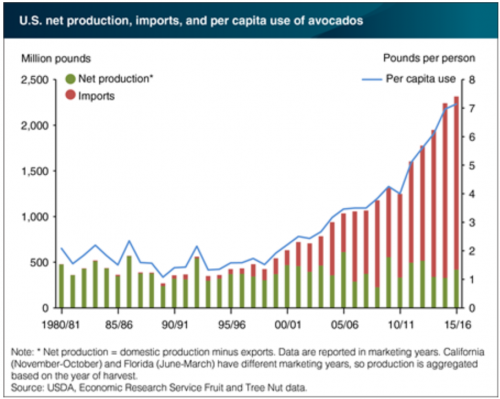Avocado consumption: environmental and social considerations
Changes in supply and demand of avocados and their consequences
America’s new favorite fruit is the avocado. The country’s large Latino population and the fruit’s yummy taste are not the only contributing factors to the rising popularity. With the help of the media, Americans are quickly learning about the incredible health benefits avocados can have.
Research has found that those who eat more avocados (and even more calories overall) weighed less than those who didn’t. The healthy fat found in avocados are monounsaturated fats (MUFAs), the same kind of good fat found in olive oil and nuts. The health benefits gained from consuming these healthy fat alternatives is not limited to only anti-obesity results. In fact, studies have found that eating avocado may also help with more serious health concerns such as preventing diabetes, high blood pressure and lowering cholesterol levels.
The benefits we get from eating an avocado are undeniably great. But like everything else in life, receiving a benefit comes at a cost- and I’m not talking about the $1.95 extra we pay to have guacamole on our tacos. I’m talking about the social and environmental costs of America’s increasing obsession of wanting avocado all year round. According to the USDA, avocado consumption per capita has increased 443 percent in the last 20 years from 1.6 pounds in 1995 to a record high of 7.1 pounds in 2015.
The majority of the avocados grown in the United States comes from California, followed by Florida and Hawaii. However, since we have become the world’s biggest consumer of this fruit, our country’s farmers cannot keep up. Today, over 80 percent of the avocados we eat come from other countries, primarily from Mexico and smaller amounts from Chile and Peru. In just 10 years, imports of avocado to the U.S. rose 41 percent.

Now that avocados are becoming more prominent on menus, it leads us to believe that avocados are in season all year round. But avocados are not a commodity, they are a seasonal fruit. Avocado season starts in March and ends in late July in California. It’s good to know when avocado season is in our own country because when you buy avocado at any other time you are more than likely buying avocado from another country, which means more greenhouse gas emissions from transportation and less support towards farmers in our own country.
The increasing demand for this tasty fruit in America is not sustainable. As a result of the demand from the US for avocados, farmers in Mexico are influenced to increase the size of their farms, which is now leading to environmental issues including deforestation and increased greenhouse gas emissions. In our own country, a drought that started in 2012 and has lasted until a few months ago in California has led to avocado prices rising to an all-time high.
If you’re one to not care much about the environment, perhaps consider the more unjust reason avocado went from being just a tasty fruit to what some call “green gold”. According to several news sources, avocado growers and pickers in Mexico reported being extremely unhappy with the wages they receive, leading them to hold a workers strike and slowing down the supply of avocados into the U.S. Like many agricultural jobs, the workdays are long and hard, income is insufficient, child labor is common, and the job itself is insecure. The resolution of the avocado strike remains unclear.
Clearly, the dollar amount we pay for avocados might seem high at face value, but knowing more about the health benefits, and the environmental and social costs of eating this fruit, will hopefully help put everything into perspective next time you decide to indulge yourself in this luxurious treat. If you’re looking for good fats to eat during the off season, eggs, walnuts and fish caught in Lake Superior (lake trout, salmon, whitefish), are among some alternatives to avocados that will not only help your health, but will also support local Michigan farmers. Michigan State University Extension promotes healthy eating, a variety of sources for nutritional balance, and the Michigan farmers and fishers that provide food in our state.



 Print
Print Email
Email


